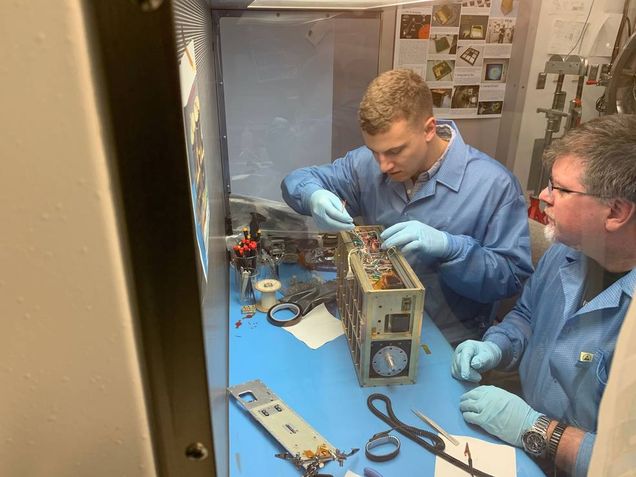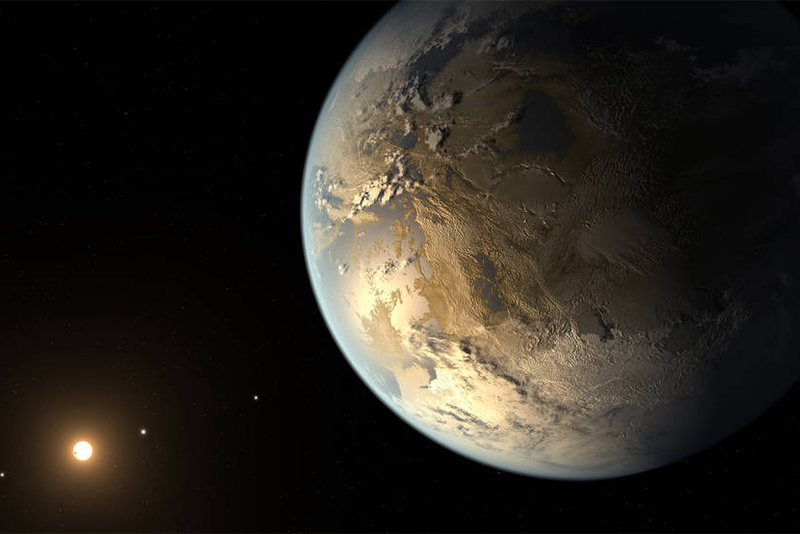News
With Space Tourism a Reality, Will Civilians Travel to Space? And When?
Majd Mayyasi (GRS’09,’13), a BU Center for Space Physics senior research scientist, discusses the future of civilian space travel and how it would impact the study of space with BU Today editor Doug Most. She also shares her experience training for suborbital flight as part of an inaugural program for scientists.
Transcript
Dana Ferrante: This is Question of the Week, from BU Today.
With space tourism now a reality, will civilians travel to space, and when? This summer, billionaires Jeff Bezos and Richard Branson each took a suborbital flight in their respective supersonic rockets, launching a new era of space travel, where a ticket to space is available to anyone who can afford it.
In this episode, Doug Most asked Majd Mayyasi, a senior research scientist at the Center for Space Physics at Boston University, about the future of civilian space travel. Mayyasi also shares her experience training for suborbital flight as part of an inaugural program for scientists.
Doug Most: Hi, Majd. Okay, let’s talk space.
So when I read the stories about Bezos and Branson, I admit that I wondered, if given the opportunity, would I want to go up to space? Seeing Earth from above and experiencing weightlessness would be incredible, that’s not really debatable, but is that enough? What do you think? Will space tourism become a real thing?
Majd Mayyasi: Well, Doug, this is a really good question. And one that I’ve been thinking about for a long time, way before Jeff Bezos and Richard Branson made interesting flights. About 11 years or so ago, there was an opportunity for scientists to train for suborbital flight. And the reason they were doing this was because they knew that ultimately this would become a reality, space tourism and space travel.
And also they wanted to get scientists engaged in this opportunity, so it’s been a project that has been in the workings for a very long time. And I actually partnered up with a group that was training scientists to do these suborbital flights. And so I was lucky to be a member of one of the first groups of scientists that got the train for this.
And we trained for the Virgin Galactic module, so it’s been something I’ve been thinking about for a long time. And since that time, you know, would I actually go to space if I had the opportunity? And the answer is most definitely yes. It is by far one of the coolest things I’ve ever done.
It’s extremely engaging to talk about with other people, especially when I do outreach to communities. And in talking to children about what you can do as an astronomer, or how to engage them in astronomy, it’s super fun to tell them that you can potentially go to space someday—if that’s something that you’re interested in—without having to go through all the rigorous training that an astronaut would go through [to become] a full-fledged astronaut.
And so there’s a lot of cool opportunities, and I’m happy to see that this is starting to become more and more of a tangible reality.
Read the full Transcript and/or listen to the podcast here:
With Space Tourism a Reality, Will Civilians Travel to Space? And When?
Small Satellite, Big Questions: CuPID CubeSat Will Get New Perspective on Sun-Earth Boundary
CSP's Assistant Professor Brian Walsh's CuPID cubesat was highlighted by NASA:
When you help build a satellite the size of a shoebox, you learn pretty much everything about it, says Emil Atz, a PhD candidate in Mechanical Engineering at Boston University. You learn how to write a proposal to fund it, how to place the screws that hold it together, how to test each instrument to ensure it functions properly.
And then you learn how to say goodbye.
“It's a scary feeling, working on a piece of hardware full-time for four years, and then putting it into the rocket deployer to never see it again,” Atz said. “I didn't want to close the door.”
This September, a rocket will launch from Vandenberg Space Force Base in California, bringing with it Landsat 9, a joint mission of NASA and the U.S. Geological Survey. The rocket will also carry four CubeSats – compact, box-shaped satellites used for space research projects.
Compared to standard satellites, CubeSats are inexpensive to launch. Just like when friends split a cab fare, tiny satellites can hitch a ride on rockets carrying several other missions, bringing down the cost for each.
One of the CubeSats launching with Landsat 9 is the Cusp Plasma Imaging Detector, or CuPID. No larger than a loaf of bread nor heavier than a watermelon, CuPID has a big job. From orbit about 340 miles (550 kilometers) above Earth’s surface, little CuPID will image the boundary where Earth’s magnetic field interacts with the Sun’s.
Atz is part of a team of collaborators from NASA’s Goddard Space Flight Center in Greenbelt, Maryland, Boston University, Drexel University, Johns Hopkins University, Merrimack College, Aerospace Corporation, and University of Alaska, Fairbanks who made CuPID possible.

BU-Made Telescope Going to the Moon in 2023
CSP's Assistant Professor Brian Walsh's LEXI Telescope was highlighted:
To prepare for the next giant leap in space exploration—traveling to Mars—the NASA Artemis program is planning to send humans back to the moon by 2024. But first, Artemis scientists are sending up a bunch of science projects, and a BU telescope is one of them.
The Lunar Environment Heliospheric X-ray Imager (LEXI) is being designed and built in a lab on Cummington Street by a team of engineers led by Brian Walsh, a BU College of Engineering assistant professor of mechanical engineering. In 2023, LEXI will be hitching a ride on Firefly Aerospace’s Blue Ghost lunar lander, alongside nine other science and technology payloads.
Read the rest of the Article here:
NYTimes: The Moon Has a Comet-Like Tail. Every Month It Shoots a Beam Around Earth.
In a recent article from NYTimes, CSP's Senior Research Scientist Jeffrey Baumgardner discusses the comet-like tail of the Moon.
An animation shows how sodium atoms ejected from the lunar surface are affected by the moon’s orbit around planet Earth. Video by James O’Donoghue/@PhysicsJ, based on simulations by Jody K. Wilson.
Carl Sagan once said that Earth is but a “mote of dust suspended in a sunbeam.” He would probably be thrilled to know that, around the time of a new moon, Earth is a speck of dust suspended in a moon tail.
The moon, lacking an atmosphere to shield it, is constantly under attack. When meteorites bombard its volcanic surface, sodium atoms fly high into orbit. The sun’s photons collide with the sodium atoms, effectively pushing them away from the sun and creating a tail-like structure flowing downstream from the moon.
“It makes the moon sort of look like a comet,” said Jeffrey Baumgardner, a senior research scientist at Boston University’s Center for Space Physics. “It has a stream of stuff coming off it.”
Read the rest of the Article here:
https://www.nytimes.com/2021/03/04/science/moon-tail-beam.html
BU Research: Looking for Extraterrestrial Life
In a recent BU Research article, CSP's Professor Michael Mendillo, Professor John Clarke, and Associate Professor Paul Withers, as well as PhD candidate Paul Dalba (Astronomy), discuss narrowing the search for extraterrestrial life with Barbara Moran.
“What more important question could we ask? Are we alone?” asks Boston University professor of astronomy Michael Mendillo. “I don’t know of any more fascinating question in science.”
For decades, astronomers have been searching these distant exoplanets for signs of life, mostly looking for that most essential molecule, water. But Mendillo and his colleagues have a different idea. In a paper published in Nature Astronomy on February 12, 2018, Mendillo, BU associate professor of astronomy Paul Withers, and PhD candidate Paul Dalba (GRS’18) suggest looking instead at an exoplanet’s ionosphere, the thin uppermost layer of atmosphere, which is whizzing with charged particles. Find one like Earth’s, they say, packed with single oxygen ions, and you have found life. Or, at least, life as we know it.
Read the rest of the Article here:
http://www.bu.edu/research/articles/habitable-exoplanets/

BU Today: Space Science for Kids
Lily (second from left) was among the throng of youngsters at who visited CSP for our Space Science for Kids event, a free event for children over 10 hosted by BU’s Center for Space Physics June 15. Sophia Kressy (CAS’19) (right) explains a gyroscope to the fascinated Lily. The event showcased interactive experiments and gave kids a chance to interact and talk with scientists about their field.
